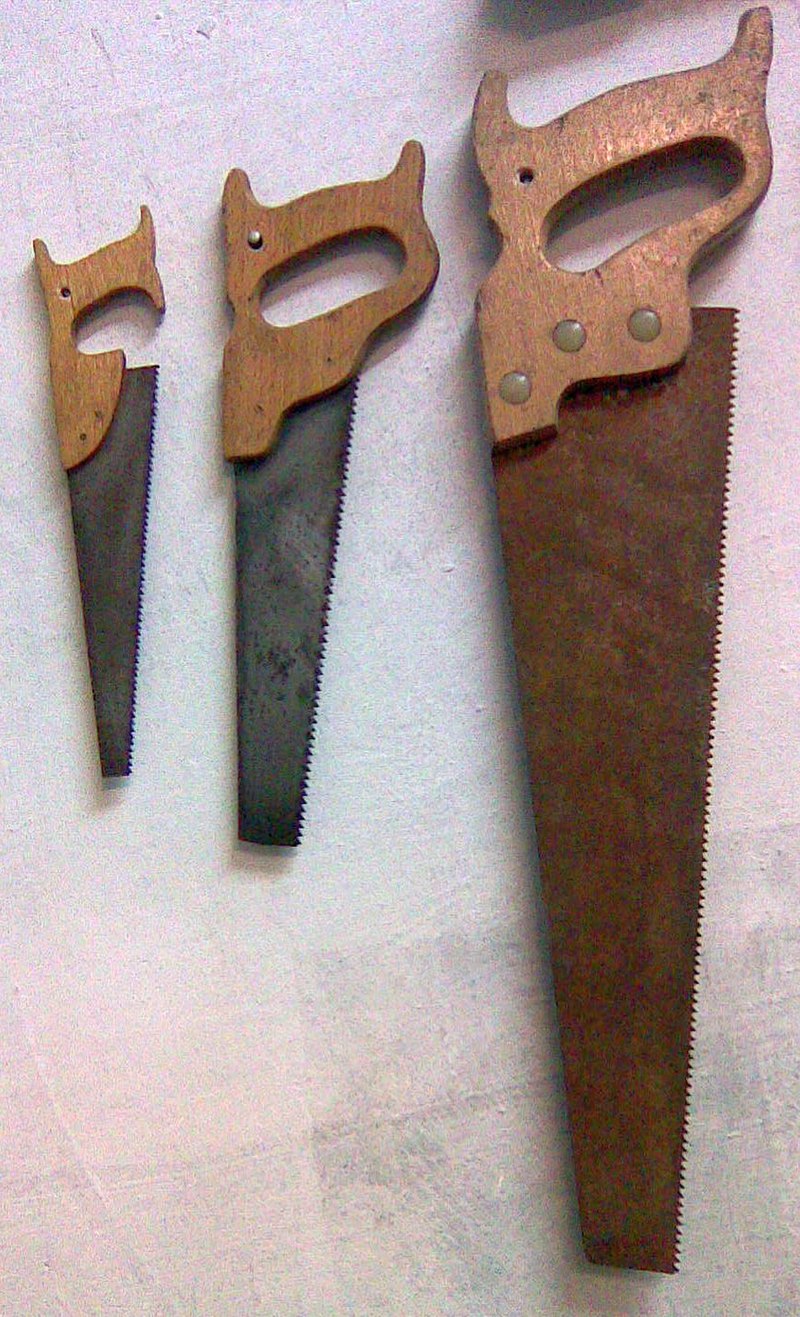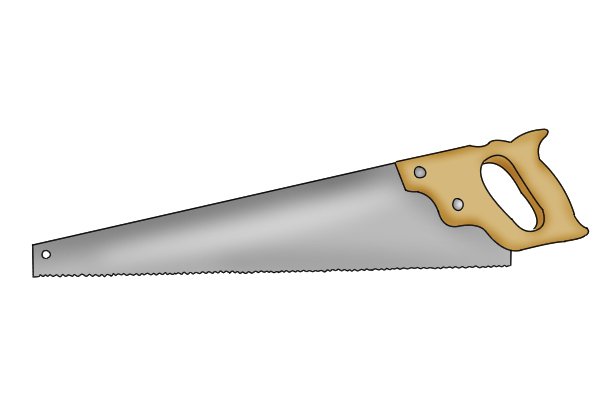Looking to learn about hand saw blades? Ever wondered what they are made of? Well, you’ve come to the right place! In this article, we’ll explore the fascinating world of hand saw blades and discover what materials they are crafted from. So, let’s dive right in and uncover the secrets behind these essential tools!
When it comes to hand saw blades, the material used plays a crucial role in their performance and durability. So what are these blades made of? One common material is steel, which is known for its strength and ability to maintain a sharp edge. But did you know that there are different types of steel used for these blades? We’ll delve into that shortly, so stay tuned!
Now, you might be thinking, “Why does the material matter?” Well, my curious friend, the material affects various aspects of the blade, such as its cutting ability, flexibility, and overall lifespan. By understanding what hand saw blades are made of, you’ll have a better idea of which one is right for your specific cutting needs. So, without further ado, let’s jump into the world of hand saw blades’ materials and explore the possibilities that await!

What Are Hand Saw Blades Made Of?
Hand saw blades play a crucial role in cutting through a variety of materials, from wood to metal. But have you ever wondered what these essential tools are made of? In this article, we will explore the different materials used to craft hand saw blades and delve into their characteristics and benefits. Whether you’re a DIY enthusiast or a professional woodworker, understanding the composition of hand saw blades can help you make informed decisions when choosing the right tool for your projects.
1. High Carbon Steel
High carbon steel is a common material used in hand saw blade manufacturing. It is a durable alloy made by combining iron and carbon. The high carbon content enhances the blade’s strength and hardness, making it ideal for cutting tasks that require precision and control. High carbon steel hand saw blades are known for their sharpness and longevity. They can withstand heavy use without losing their cutting edge. Additionally, these blades are relatively affordable, making them a popular choice among craftsmen and DIYers.
Benefits of High Carbon Steel Hand Saw Blades:
– Long-lasting sharpness: High carbon steel blades can retain their sharpness even after prolonged use.
– Versatility: These blades are suitable for cutting a wide range of materials, including wood, plastic, and non-ferrous metals.
– Cost-effective: High carbon steel blades offer excellent performance at a budget-friendly price.
Things to Consider:
– Prone to rust: High carbon steel blades are susceptible to rust, so proper maintenance and storage are essential to prolong their lifespan.
– Brittle: Although durable, high carbon steel blades can be prone to breaking or chipping if not used with care.
2. Bi-Metal Blades
Another popular material used in hand saw blades is bi-metal. As the name suggests, this type of blade is made by combining two different metals. Typically, it consists of a high-speed steel edge, which provides excellent cutting performance, and a flexible spring steel spine that adds durability and resilience. Bi-metal blades offer the best of both worlds, combining the sharpness and cutting ability of high-speed steel with the strength and flexibility of spring steel.
Benefits of Bi-Metal Hand Saw Blades:
– Longer lifespan: The combination of high-speed steel and spring steel results in a durable blade that can withstand intense cutting tasks.
– Versatile: Bi-metal blades are suitable for cutting various materials, including wood, metal, plastic, and even nails.
– Heat-resistant: These blades can resist heat buildup during cutting, reducing the risk of blade damage or warping.
Things to Consider:
– Higher cost: Bi-metal blades tend to be more expensive than high carbon steel blades due to their advanced composition.
– Potential for blade deflection: The flexibility of the spring steel spine may cause the blade to deflect during aggressive cutting, affecting precision.
3. Carbide-Tipped Blades
Carbide-tipped blades are designed for heavy-duty cutting applications, typically in woodworking and construction industries. These blades are made by bonding a thin layer of tungsten carbide to a steel body. Tungsten carbide is an extremely hard and wear-resistant material known for its superior cutting performance and longevity. Carbide-tipped blades excel in cutting through hardwoods, laminates, and other challenging materials, offering unmatched durability and precision.
Benefits of Carbide-Tipped Hand Saw Blades:
– Exceptional cutting performance: The hardness of tungsten carbide ensures efficient cutting and resistance to wear, resulting in clean and precise cuts.
– Longevity: Carbide-tipped blades have an extended lifespan compared to other blade types, making them a cost-effective investment for professionals.
– Reduced blade maintenance: These blades require less frequent sharpening, saving time and effort.
Things to Consider:
– Higher cost: Carbide-tipped blades are more expensive than other blade types due to the high-quality tungsten carbide used in their construction.
– Brittle: While carbide is highly durable, it can be susceptible to chipping if subjected to lateral forces or mishandling.
4. Diamond Blades
When it comes to cutting through extremely hard materials like concrete, stone, or ceramics, diamond blades are the go-to choice. As the name suggests, diamond blades have diamond grit embedded within the cutting edge. Diamonds are the hardest natural material on Earth, providing exceptional cutting power and longevity. Diamond blades are commonly used in construction and masonry work and are available in various designs, including continuous rim, segmented, and turbo rim blades.
Benefits of Diamond Hand Saw Blades:
– Extreme cutting power: Diamond blades can effortlessly cut through the toughest materials, including reinforced concrete and porcelain tiles.
– Long lifespan: The hardness and durability of diamonds ensure that these blades can withstand heavy use without losing their cutting efficiency.
– Precision cutting: Diamond blades produce clean and precise cuts, minimizing the need for additional finishing or smoothing.
Things to Consider:
– Limited material compatibility: Diamond blades are specifically designed for cutting hard materials and may not be suitable for other materials like wood or plastics.
– Higher cost: Diamond blades are the most expensive type of hand saw blade due to the premium material used in their construction.
5. Other Materials
Apart from the main materials mentioned above, hand saw blades can also be made from other alloys or composites depending on specific cutting requirements. For example, some blades feature titanium coating for increased hardness and improved cutting performance. Others may incorporate specialized coatings or treatments to enhance their corrosion resistance or reduce friction during cutting. It is essential to consider the specific characteristics and applications of these specialized blades when selecting the right tool for your projects.
Conclusion:
Understanding the materials used in hand saw blade construction is vital for selecting the right tool for your cutting tasks. While high carbon steel, bi-metal, carbide-tipped, and diamond blades are the most commonly used, it’s important to consider the specific requirements of your project and choose a blade with the appropriate material composition. Whether you’re working with wood, metal, or other challenging materials, there is a hand saw blade available to suit your needs. Remember to properly maintain and store your blades to maximize their lifespan and ensure optimal cutting performance.
Key Takeaways: What are Hand Saw Blades Made of?
- Hand saw blades are typically made of high-quality steel.
- Some hand saw blades may also incorporate tungsten carbide or diamond grit for added cutting power.
- Steel is chosen for its durability, sharpness, and resistance to corrosion.
- Hand saw blades may have different tooth configurations, such as crosscut or rip cut, depending on the desired cutting action.
- Proper maintenance and sharpening of hand saw blades are essential for optimal performance and longevity.
Frequently Asked Questions
Hand saw blades are essential tools for various woodworking and DIY projects. If you’re curious about what these blades are made of, we have some answers for you:
1. What materials are commonly used to make hand saw blades?
Hand saw blades are typically made of high-quality steel or carbon steel. High-quality steel blades offer excellent durability and cutting precision. Carbon steel blades, on the other hand, are known for their sharpness and affordability. Both materials are commonly used due to their strength and ability to hold a sharp edge.
Some hand saw blades may also feature special coatings, such as chrome or nickel, to enhance their corrosion resistance and extend their lifespan.
2. Are there any other materials used in the construction of hand saw blades?
In addition to steel or carbon steel, hand saw blades can sometimes incorporate other materials in their construction. For example, some blades may have teeth made of carbide, a hard and durable material known for its resistance to wear and tear. Carbide teeth can be particularly beneficial when cutting through tough materials like metal or hardwood.
Furthermore, some hand saw blades designed for specific purposes, such as cutting ceramic tiles or plastic, may be made using diamond or abrasive particles to ensure efficient and precise cutting.
3. How is the blade hardness and flexibility achieved?
The hardness and flexibility of hand saw blades are carefully balanced during the manufacturing process. Achieving the right balance is crucial to ensure optimal performance and longevity. To achieve the desired hardness, blades can be heat-treated or tempered. This process involves heating the blade to a specific temperature and then cooling it rapidly or slowly, depending on the desired characteristics.
Additionally, the teeth of the saw blades are often hardened to enhance their cutting ability, while the rest of the blade’s body is made more flexible to handle the stress and strain during cutting.
4. Can hand saw blades be sharpened?
Yes! Hand saw blades can be sharpened if they become dull over time. However, sharpening a hand saw blade requires skill and the right tools. It is recommended to seek professional sharpening services or use specialized sharpening tools designed for hand saw blades. Improper sharpening techniques can damage the blade or affect its cutting performance.
It’s also worth noting that hand saw blades have a limited number of sharpening cycles. Eventually, the blade may become too thin or worn to sharpen effectively, and it will need to be replaced.
5. What should I consider when choosing a hand saw blade?
When selecting a hand saw blade, consider the specific task or material you’ll be cutting. Different blades have varying tooth patterns and sizes, designed for specific applications. For example, a blade with fine teeth is ideal for precise, smooth cuts, while a blade with larger teeth is better suited for fast, rough cuts.
Additionally, consider the length and width of the blade to ensure it matches the cutting depth and the size of your workpiece. Furthermore, be aware of the blade’s compatibility with your saw, ensuring it is the correct size and fits securely without any wobbling or slipping.

Crosscut & Ripcut Saws; What’s the Difference? | Paul Sellers
Summary
Hand saw blades are commonly made of high-carbon steel or bi-metal materials. High-carbon steel blades are durable and inexpensive, but they may lose their sharpness quicker. Bi-metal blades, on the other hand, have a high-speed steel edge combined with a flexible spring steel back, making them strong and long-lasting. It’s important to choose the right blade for the job to ensure efficient and precise cutting. Different blades are designed for cutting wood, metal, or plastic, so it’s essential to use the appropriate one for your specific needs. Proper maintenance, such as cleaning and sharpening, can extend the lifespan of a hand saw blade.
